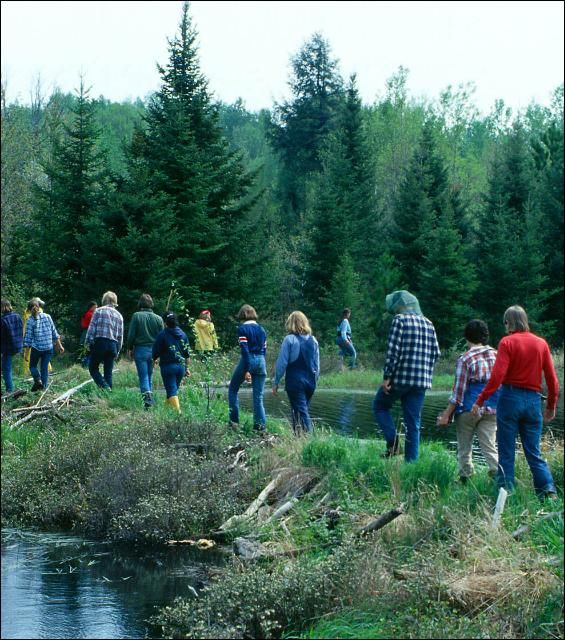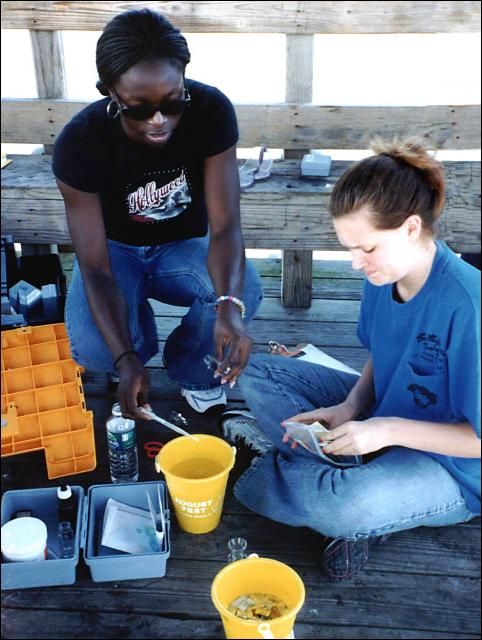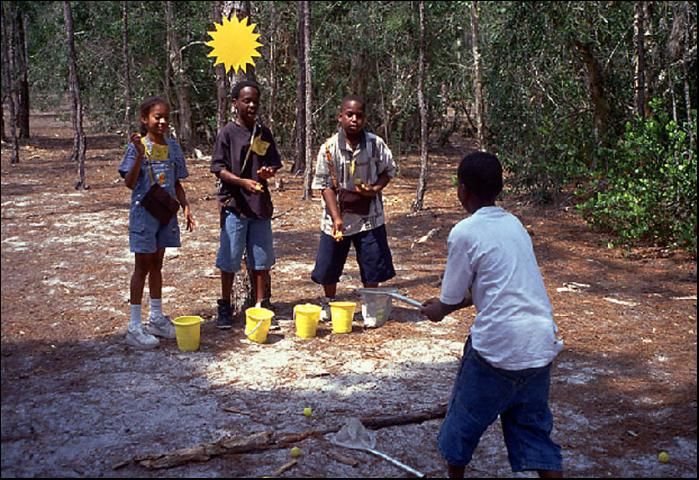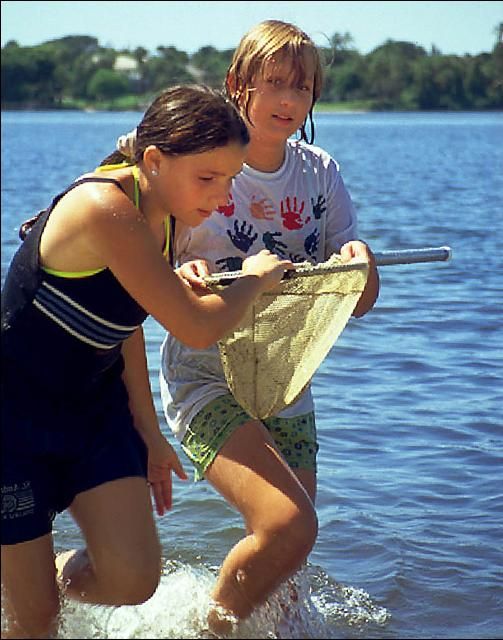Most educators are familiar with what has become a childhood ritual—the field trip. Taking youth to parks, school camps, nature centers, and other outdoor settings provides an important contribution to the learning process (See Figure 1). Researchers have documented the cognitive and affective benefits of field trips, including increased motivation for learning (Kern and Carpenter, 1984), a more positive attitude toward science and environmental concepts (Bitgood, 1989), and the acquisition of knowledge and skills (Mackenzie and White, 1981). Further, field trips can stimulate interest for natural resource-related careers and result in an improved attitude toward the site visited (Knapp, 2000). But not all field trips result in these benefits. A field trip can easily turn into nothing more than a day off from school. This fact sheet explains how to maximize learning during the field trip to ensure that students gain its cognitive and affective benefits.

Credit: Photo courtesy of M. Monroe and used with permission.
1. Ensure that the Field Trip Is an Integral Part of the Broader Curriculum
Too often, field trips are isolated from the rest of the school curriculum. Research, however, has shown that there is less transfer of learning and less meaning when the field trip is not related to classroom teaching (Ferry, 1995). The field trip should be integrated into the broader instructional program and be used only when it is the most effective and efficient procedure for fulfilling the learning objectives. When working within the formal education setting, make sure field trips are relevant to the school's curriculum and that they support state education standards and current reform efforts.
Florida's Next Generation Sunshine State Standards provide a statewide guide to curriculum in public schools. Of course science standards are readily met on natural resource field trips, but it is also possible to develop a natural resource-focused field program that helps teachers meet standards in language arts, mathematics, and social studies. For example, a trip to a nature center for fourth-grade students could include an exploration of the forest ecosystem, collecting impressions to write a story, and calculating how many insects might be in a rotting log. The trip could then address the following standards:
SC.4.L.17.2: Explain that animals, including humans, cannot make their own food and that when animals eat plants or other animals, the energy stored in the food source is passed to them.
LA.4.4.2.1: Write in a variety of informational/expository forms.
MA.4.A.6.6: Estimate and describe reasonableness of estimates; determine the appropriateness of an estimate versus an exact answer.
2. Integrate the Field Trip into an Instructional Unit
Orion (1993) offers a three-part model that can be used to integrate field trips into the curriculum. Each part is a structured, independent learning unit, yet each links naturally to the next part of the model. The first part, the preparatory unit, prepares students for the field trip with targeted learning activities—usually incorporating some "hands-on" tasks. Learners might work with materials and equipment that will be used in the field and gain the basic concepts and skills necessary for the completion of field activities.
The field trip is the second and central part of the model. It serves as a concrete bridge toward more abstract learning levels. Making the field trip the central part of the instructional program, rather than using it as a summary or enrichment activity, provides the concretization learners need to move on to higher levels of cognitive learning when they return from the field.
The third part of Orion's model, the summary unit, includes more complex and abstract concepts, aiming toward helping learners to use their field trip learning and to transfer it to new situations. This component is usually conducted in the classroom.
While it may appear simple and intuitive at first glance, in fact this model advocates a significant departure from the typical stand-alone field trip. By including pre- and post-trip elements, the teacher becomes involved in the instruction of the field trip concepts, and students are more likely to make connections to other topics in the curriculum.
3. Familiarize Students with the Field Trip Site and Trip Expectations
The relative novelty or familiarity of the field trip setting affects learning. Settings that are too novel cause fear and nervousness; settings that are too familiar cause boredom, fatigue, and diversionary activities (Falk and Balling, 1980). Students learn best in a moderately novel field trip setting. It's best to familiarize them first by showing slides or a video of the field trip site and locating the field trip area and route on a map. Educators can also provide students with an itinerary of activities and details regarding the type of work they will be expected to do at each learning station, possible weather conditions, safety hazards and precautions, location of restrooms, and lunch or snacks (Figure 2).

Credit: Photo courtesy of J. Athman and used with permission.
Staff at the field trip site can provide teachers with pre-trip materials, maps, and resources that can help teachers prepare students for the field experience. In addition to suggesting content-based activities that would introduce topics, vocabulary, and concepts (see section 2), staff might provide a map of the route the bus could take and a map of the facility's trails that will orient students to the site. Teachers may be able to provide a slide show of last year's field trip, or readings from those students' reports. A letter to parents is another strategy to prepare youth for the upcoming field trip. It alerts parents to the event and encourages them to make sure students have appropriate clothing and necessary equipment. If the bus route passes an area of interest, such as a river, a former wildfire site, or a wetland, teachers may be able to point out these landmarks as students make observations.
4. Design the Field Trip as a Learning Experience Based on Educational Theory
The main instructional strategy of the field trip should be hands-on experience, focusing on activities that cannot be conducted in the classroom or laboratory (Orion, 1993). Rather than passively absorbing information through guided tours or participating in simulations, students should be actively constructing knowledge through their interactions with the environment. This strategy relies on a process-oriented rather than a content-oriented approach, incorporating activities such as observing, identifying, measuring, and comparing. Instructors should build in opportunities for structured exploration, such as scavenger hunts or sensory awareness activities. Further, the actual site of the field trip should be conducive to learning. Terrain that is too difficult, learning stations that are separated by great distances, extreme weather conditions, and constant pestering by mosquitoes make learning difficult.
The "stop and talk" approach many naturalists use is not sufficiently engaging for young learners. Consider asking students to find examples of insect feeding, three different shades of green, or animal homes. Readily available activities from Project Learning Tree, Project WET, and Project WILD offer ideas for outdoor games and exercises that bring concepts like camouflage, watershed, and population growth to life (Figure 3).

Credit: Photo courtesy of M. Monroe and used with permission.
5. Provide Students with Multiple Exposures to and Experience in Natural Settings
Some students, often those from urban backgrounds, arrive at the park or natural area with negative preconceptions and fears that interfere with the effectiveness of the field trip program (Bixler, Carlisle, Hammitt, and Floyd, 1994). These students need repeated positive exposures to natural settings to lower the novelty of these settings and help them "unlearn" misconceptions. Direct experiences can be planned to counter perceived threats, such as encountering dirt and germs, getting lost, and being attacked by venomous snakes or ravenous wolves. When possible, field trips should be provided to young children (as young as preschool and kindergarten) to prevent their developing these fears in the first place. With enough exposure and support, these students may be able to introduce their families to positive encounters with nature.
With the rising cost of bus transportation for field trips, it can be difficult for teachers to make multiple trips to natural settings. It may be wise to help teachers develop natural areas on their school sites. Also called "outdoor classrooms" and "land labs," these nearby locations can give teachers a place to conduct a variety of environmental activities. Similarly, a city park or cemetery can also provide areas to explore insects, plants, soil, and trees. The more comfortable youth become with these familiar, nearby locations, the better they will be able to appreciate more wild environments.

Credit: Photo courtesy of M. Monroe and used with permission.
Summary
Field trips can be a valuable method of instruction, providing students with important cognitive and affective benefits. To help ensure that students actually gain these potential benefits, instructors must consider the factors that influence the educational effectiveness of field trips. They must integrate the field trip into the curriculum and align it with national and state education standards using pre- and post-visit activities; familiarize students with the field trip site and trip expectations; base the field trip on solid educational theory; and provide students with multiple experiences in natural settings. Extension agents, club leaders, agency staff, and classroom teachers aware of the importance of these factors can collectively plan and implement field trips that achieve optimal cognitive and effect results, as well as provide youth with the opportunities to enjoy and explore an outdoor environment.
References
Bitgood, S. (1989). School field trips: An overview. Visitor Behavior, 4(2), 3-6.
Bixler, R., C. Carlisle, W. Hammitt, and M. Floyd. (1994). Observed fears and discomfort among urban students on field trips to wildland areas. The Journal of Environmental Education, 26(1), 24-33.
Falk, J. and J. Balling. (1980). The school field trip: Where you go makes a difference. Science and Children, 6-8.
Ferry, B. (1995). Enhancing environmental experiences through effective partnerships among teacher educators, field study centers, and schools. The Journal of Experiential Education, 18(3), 133-137.
Kern, E. and J. Carpenter. (1984). Enhancement of student values, interests, and attitudes in earth science through a field-oriented approach. Journal of Geological Education, 32, 299-305.
Knapp, D. (2000). Memorable experiences of a science field trip. School Science and Mathematics, 11(2), 65-71.
Mackenzie, A. and R. White. (April 1981). Fieldwork in geography and long-term memory structures. Paper presented at the American Educational Research Association, Los Angeles, CA.
Orion, N. (1993). A model for the development and implementation of field trips as an integral part of the science curriculum. School Science and Mathematics, 93(6), 325-331.